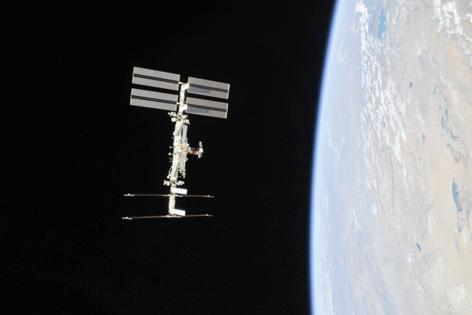With Trump eyeing space station demise, NASA pushes for commercial replacements
Published in News & Features
ORLANDO, Fla. — President Donald Trump and his new interim head of NASA Sean Duffy are pushing for a renewed effort to shuffle off the responsibility of running the International Space Station in favor of becoming a customer of a commercial space station provider instead.
NASA first doled out funds in 2021 for several groups to pursue private stations, including Blue Origin and Voyager Space, while also supporting Axiom Space to add modules to the ISS that would eventually detach to become its own freestanding station.
But little progress has been made toward realizing a commercial replacement.
Now NASA has asked for updated feedback from American companies as part of a draft Phase 2 Announcement for Partnership Proposals. The announcement made earlier this month called on the updates to be submitted by Sept. 12.
The ISS, which will be celebrating 25 years of continuous human presence in November, is slated to be decommissioned after 2030, but Trump’s proposed budget for NASA’s fiscal 2026 signaled shutting down American support sooner.
That includes reducing the number of crewed missions each year by stretching out the stays on board beyond six months, but also reducing the number of astronauts sent to the station on each mission.
Instead, Trump seeks to refocus all crewed efforts to exploration of the moon and Mars, leaving low-Earth orbit to commercial suppliers.
“NASA has led in low Earth orbit for 25 years and counting. Now, as we prepare for deorbiting the International Space Station in 2030, we’re calling on our commercial space partners to maintain this historic human presence,” Duffy said. “The American space industry is booming. Insight from these innovative companies will be invaluable as we work to chart the next phase of commercial space stations.”
NASA officials met with companies work on stations on Sept. 8 to outline expectations.
The updated push was to “ensure mission continuity, affordability, and national alignment, and to reduce the potential for a gap of a crew-capable platform in low-Earth orbit,” according to a NASA press release.
While Northrop Grumman was among the original group proposing standalone stations, that company has since dropped out to support instead Voyager Space’s station, named Starlab. The Blue Origin-led station is called Orbital Reef. Just when those companies plan to launch any infrastructure to build those stations has been a continuous moving target.
Axiom Space’s Axiom Station’s first module could fly to the ISS as early as 2027.
Meanwhile the SpaceX-backed company Vast, not included in the original NASA plans, has surged ahead with what is likely to be the first commercial space station in orbit. It’s still planning to launch its Haven-1 station from Florida in 2026.
The Phase 2 request from NASA may allow Vast to get into the funding mix.
“NASA is committed to continuing our partnership with industry to ensure a continuity in low-Earth orbit,” said NASA’s Angela Hart, manager of the Commercial Low Earth Orbit Development Program. “The work done under our Phase 1 contracts and agreements have put us in a prime position to be successful for this next funded Space Act Agreement phase.”
She said the new agreements will give commercial partners flexibility to define how best to satisfy NASA’s requirements for safety and affordability.
The requirements ultimate goal would be for a demonstration mission with four crew members for at least 30 days after a critical design review. Agreements expect to include up to a five-year period of performance.
Then would come Phase 3, when NASA actually moves into full customer mode purchasing services as needed among stations that passed the Phase 2 muster.
While Trump may have his eyes on the moon and Mars, his first NASA administrator, Jim Bridenstine, warned about any sort of gap in American presence in low-Earth orbit during recent testimony at a Senate committee hearing.
“We need to have space stations that can, in effect, replace the International Space Station. When I say that, I mean space stations that are fully mission-capable and have a permanent human presence in space,” he said.
He highlighted the technologies that have poured forth, including pharmaceutical development to treat diseases that have never been treatable before, as evidence of why America shouldn’t leave this part of space behind.
“Regenerative medicine, the ability to print in human tissue, to grow in 3D human tissue. All of these capabilities, if we don’t stay in front of it, our greatest competitor China will, and our international partners will join them in that effort,” he said.
He also noted the work done to advance materials like semiconductors and hypersonic research.
“Microgravity is critical to all of these capabilities, and we’re at risk if we don’t have a fully mission capable system,” he said.
©2025 Orlando Sentinel. Visit orlandosentinel.com. Distributed by Tribune Content Agency, LLC.







Comments